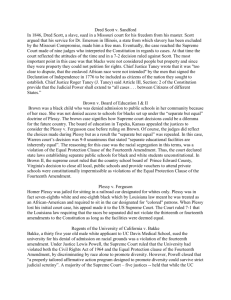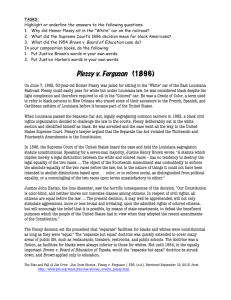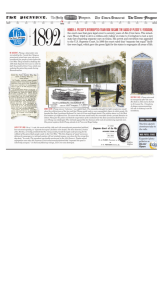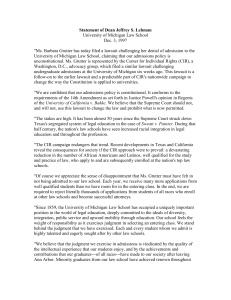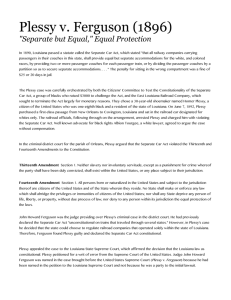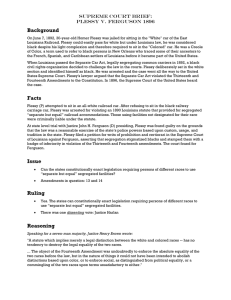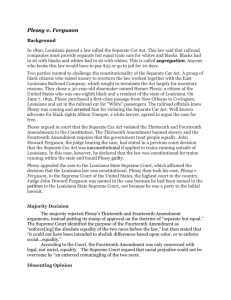Harlan, Brown, & MLK: The Content of Character v
advertisement
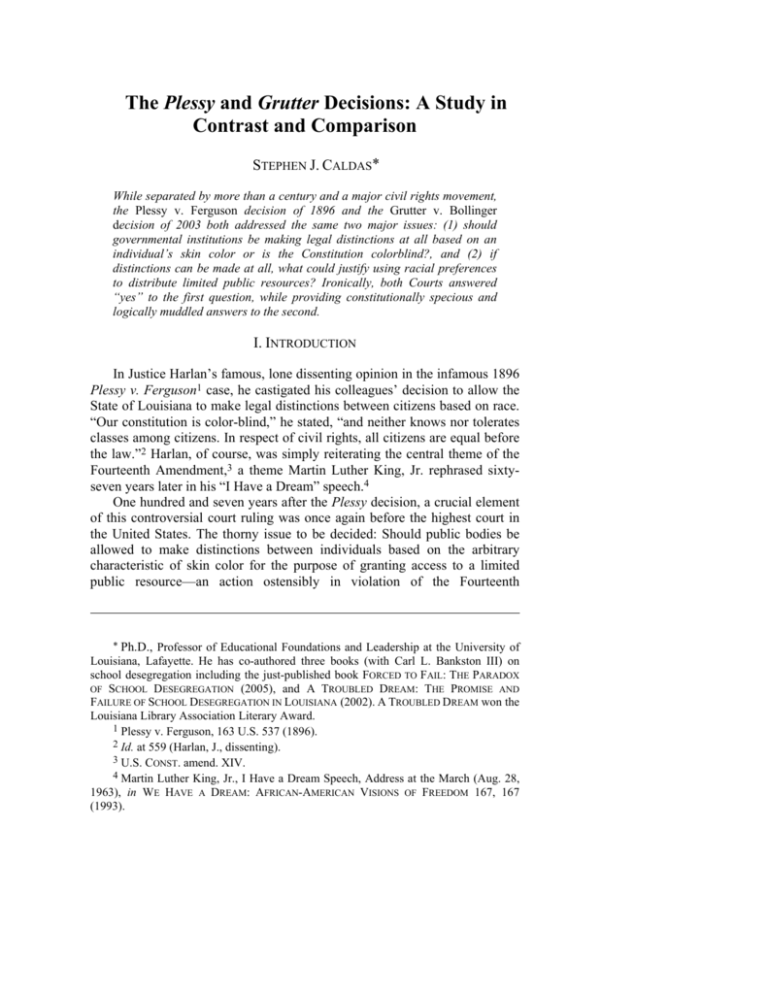
The Plessy and Grutter Decisions: A Study in Contrast and Comparison STEPHEN J. CALDAS∗ While separated by more than a century and a major civil rights movement, the Plessy v. Ferguson decision of 1896 and the Grutter v. Bollinger decision of 2003 both addressed the same two major issues: (1) should governmental institutions be making legal distinctions at all based on an individual’s skin color or is the Constitution colorblind?, and (2) if distinctions can be made at all, what could justify using racial preferences to distribute limited public resources? Ironically, both Courts answered “yes” to the first question, while providing constitutionally specious and logically muddled answers to the second. I. INTRODUCTION In Justice Harlan’s famous, lone dissenting opinion in the infamous 1896 Plessy v. Ferguson1 case, he castigated his colleagues’ decision to allow the State of Louisiana to make legal distinctions between citizens based on race. “Our constitution is color-blind,” he stated, “and neither knows nor tolerates classes among citizens. In respect of civil rights, all citizens are equal before the law.”2 Harlan, of course, was simply reiterating the central theme of the Fourteenth Amendment,3 a theme Martin Luther King, Jr. rephrased sixtyseven years later in his “I Have a Dream” speech.4 One hundred and seven years after the Plessy decision, a crucial element of this controversial court ruling was once again before the highest court in the United States. The thorny issue to be decided: Should public bodies be allowed to make distinctions between individuals based on the arbitrary characteristic of skin color for the purpose of granting access to a limited public resource—an action ostensibly in violation of the Fourteenth ∗ Ph.D., Professor of Educational Foundations and Leadership at the University of Louisiana, Lafayette. He has co-authored three books (with Carl L. Bankston III) on school desegregation including the just-published book FORCED TO FAIL: THE PARADOX OF SCHOOL DESEGREGATION (2005), and A TROUBLED DREAM: THE PROMISE AND FAILURE OF SCHOOL DESEGREGATION IN LOUISIANA (2002). A TROUBLED DREAM won the Louisiana Library Association Literary Award. 1 Plessy v. Ferguson, 163 U.S. 537 (1896). 2 Id. at 559 (Harlan, J., dissenting). 3 U.S. CONST. amend. XIV. 4 Martin Luther King, Jr., I Have a Dream Speech, Address at the March (Aug. 28, 1963), in WE HAVE A DREAM: AFRICAN-AMERICAN VISIONS OF FREEDOM 167, 167 (1993). 68 OHIO STATE LAW JOURNAL [Vol. 67:67 Amendment “equal protection” clause? In Grutter v. Bollinger,5 the Court— likewise in a split decision—decided once again that the answer to this question was “yes.”6 However, in an interesting and somewhat perplexing (and even cryptic) twist, Justice Sandra Day O’Connor, speaking for the slim majority of five justices, added, “We expect that 25 years from now, the use of racial preferences [in admissions decisions] will no longer be necessary to further the interest approved today.”7 The approved “compelling state interest,” first established by Justice Powell in the Bakke decision of 1978, was and is “diversity.”8 Furthermore, Justice O’Connor insinuated that in the long run, racial discrimination of the type practiced by university admissions committees was undesirable and unconstitutional. Indeed, the Grutter Court admitted, “We are mindful, however, that ‘[a] core purpose of the Fourteenth Amendment was to do away with all governmentally imposed discrimination based on race.’”9 The Grutter Court’s “twenty-five year clause” suggests that the racial achievement gap would be insignificant a quarter century after its ruling in 2003, and for this reason, universities would no longer need to have differential standards for some racial and ethnic applicants. Apart from the issue of whether all racial and ethnic groups will be on the same educational playing field a quarter century from now, something which current educational trends do not at all predict,10 the larger legal and social questions that the Grutter decision seems to raise are remarkably the same as they were in 1896: (1) Should governmental institutions be making legal distinctions at all based on an individual’s skin color (or was Harlan correct in his assessment over a century ago that our Constitution is “color blind”)?, and (2) If distinctions can be made at all, what could justify using racial preferences to distribute limited public resources? The Plessy Court addressed both of these questions in 1896.11 Like Grutter, the Plessy decision argued that a government could constitutionally make distinctions between 5 Grutter v. Bollinger, 539 U.S. 306 (2003). 6 Id. at 343. 7 Id. 8 Regents of the Univ. of Cal. v. Bakke, 438 U.S. 265, 315 (1978). 9 Grutter, 539 U.S. at 341–42 (citing Palmore v. Sidoti, 466 U.S. 429, 432 (1984)). 10 After narrowing during the 1970s and 1980s, the black-white achievement gap on several of America’s most important national standardized tests has either stabilized, or on several measures, has begun to widen. Results on the widening gap are reported in an exhaustive study in STEPHEN J. CALDAS & CARL L. BANKSTON III, FORCED TO FAIL: THE PARADOX OF SCHOOL DESEGREGATION (2005); see also CHRISTOPHER JENCKS & MEREDITH PHILLIPS, THE BLACK-WHITE TEST SCORE GAP (1998); PAUL E. BARTON, PARSING THE ACHIEVEMENT GAP: BASELINES FOR TRACKING PROGRESS (2003). 11 Plessy v. Ferguson, 163 U.S. 537, 543–46, 551–52 (1896). 2006] A STUDY IN CONTRAST AND COMPARISON 69 individuals based on the color of their skin. Delivering the majority opinion of the Court, Justice Billings Brown stated, “A statute which implies merely a legal distinction between the white and colored races . . . has no tendency to destroy the legal equality of the two races . . . .”12 Ironically, with just a few word changes and differing emphases, this phrase from the ignominious Plessy decision justifying the so-called “separate but equal doctrine”13 conceivably could have been uttered with a straight face by the Grutter Court, who adjured that the University of Michigan Law School’s policy allowing admissions committees to make distinctions between candidates based on race “does not unduly harm nonminority applicants.”14 As to the second question of unequal distribution of public goods, the Plessy Court argued, disingenuously it seems to this author, that Homer Plessy was not being denied the equal protection that the Fourteenth Amendment afforded him when he was both refused his right to be recognized as a white man, and denied a place on a train car reserved for whites.15 The Grutter Court did not even try to defend its decision in terms of the equality of the law as the Plessy Court, however fatuously, attempted to. Rather, the five justices in the Grutter majority argued that allowing “racial preferences” (a concept completely absent in the Plessy decision) was constitutional based on the idea of diversity being a “compelling state interest.”16 What is not so compelling is the Court’s logic linking the practice of racial discrimination in university admissions on the one hand, with societal racial diversity on the other. It is conceivable that many Justices in the Plessy majority secretly harbored a belief in racial discrimination as a justification for their decision (racial preferences for whites, that is), but did not dare speak it so directly into public record. 12 See id. at 543. 13 The phrase “separate but equal” is actually contained in Justice Harlan’s dissenting opinion found in the Plessy v. Ferguson decision. Id. at 552 (Harlan, J. dissenting). 14 Grutter v. Bollinger, 539 U.S. 306, 341 (2003). 15 See Plessy, 163 U.S. at 538, 548–50, 552. Mr. Plessy, who was seven-eighths white, insisted that his race was white and that the State of Louisiana had no justification for classifying him as a black man. When Plessy was ejected from the train car in 1892, Louisiana was operating under the “one-drop rule,” defining as a Negro anyone with a trace of black ancestry. For a more in-depth historical investigation of race as a social construction, especially during the time of Jim Crow, see Daniel J. Sharfstein, The Secret History of Race in the United States, 112 YALE L.J. 1473 (2003); and Ian F. Haney Lopez, The Social Construction of Race: Some Observations on Illusion, Fabrication, and Choice, 29 HARV. C.R.-C.L. L. REV. 1, 6–7, 11–17 (1994). 16 See Grutter, 539 U.S. at 322–25. 70 OHIO STATE LAW JOURNAL [Vol. 67:67 The Grutter Court did not expressly deny that the affirmative action policy of the University of Michigan Law School was discriminatory and that its policy of considering race as a “plus” factor (established from precedent set forth in Bakke17) redistributed a public good based at least in part on the arbitrary characteristic of a person’s race. Rather, the Court concurred with the university’s rationale of granting admissions preferences to minorities based on some nebulous “critical mass” theory. The majority stated: [T]he Law School defines its critical mass concept by reference to the substantial, important, and laudable educational benefits that diversity is designed to produce, including cross-racial understanding and the breaking down of racial stereotypes. The Law School’s claim is further bolstered by numerous expert studies and reports showing that such diversity promotes learning outcomes and better prepares students for an increasingly diverse workforce, for society, and for the legal profession.18 First, it is important to make clear that there is very little agreement among social scientists over the relationship between diversity on the one hand, and positive academic outcomes on the other. Indeed, there is much research that suggests that diversity could in some instances actually hurt academic achievement.19 The crux of the issue seems to center on the “type” of diversity. Secondly, there is the whole nebulous notion of what constitutes a “minority” in the first place. For example, are Asian Americans minorities?20 They are not according to the University of Michigan, which specifically mentions African American, Hispanic, and Native American students as those individuals qualifying to receive special consideration in the admissions process. While it can be argued that these three groups are both underrepresented in universities and historically have all been the subjects of discrimination21 in the United States, similar arguments could be made in favor of granting preference to white Appalachians and Louisiana 17 Regents of the Univ. of Cal. v. Bakke, 438 U.S. 265, 317–18 (1978). 18 Grutter, 539 U.S. at 308 (quoting from syllabus). 19 We summarize much research, including our own, on the effects of varying kinds of diversity on academic achievement in CALDAS & BANKSTON, supra note 10, at 47, 63– 64, 200–01. 20 Rather than being given preferences in admissions to American universities because of historical discrimination, which is no longer permissible, Asian Americans as a group are actually the most disadvantaged by affirmative action policies because of their overrepresentation on American campuses. It makes one wonder how this discrimination against Asian Americans is any different from limits once set as to the number of Jews who could enter America’s most elite universities and colleges. 21 The Bakke decision expressly ruled out societal discrimination as a basis for affirmative action. See Bakke, 438 U.S at 310. 2006] A STUDY IN CONTRAST AND COMPARISON 71 Cajuns.22 In spirit, this whole debate about who is a minority has remarkable parallels to the Plessy Court’s deliberations about Homer Plessy’s race.23 Let us assume for the sake of argument that the Court is accurate in its declaration that diversity promotes positive learning outcomes, and that it knows which minority groups need preferential treatment in gaining access to America’s top colleges and universities. There is still another conundrum. I am not sure what percentage of minority students would trigger the “critical mass” of diversity at the University of Michigan Law School, initiating this chain reaction of “cross-racial understanding.”24 But one would suppose that a necessary precursor to such an explosion of empathy would be a dramatic increase in cross-racial interaction between students. In other words, just sitting next to a minority is unlikely to trigger racial understanding. Though decidedly not based on the putative expert research like that shared with the Grutter Court, the personal observations of this researcher would suggest that this “critical mass” might be something beyond seventeen percent minority enrollment. African American students comprise seventeen percent of the student body at the University of Louisiana, Lafayette.25 Though there is of course some friendly cross-racial interaction on campus, with little obvious racial tension at this university of about 16,000 students, segregation at the group level appears to be the norm. For example, I approached my university’s student union early in the 2005 spring semester while ruminating on the meaning of the Grutter decision in preparation for writing this Article, when I came upon approximately fifty African American students enjoying the sun, listening to music, and informally socializing. Whereas white students traversed this large group to enter and exit the union, I counted not one white student interacting with even one black student in this large, impromptu student gathering with no obvious constraints on individual choice of freedom of association. Moreover, this segregated gathering at the student union was not an aberration, but rather seemed to be the norm, as I have observed pretty much the same dynamic during the years that I have taught at the University of Louisiana, Lafayette. Informal reports shared with this author from schools and universities across the United States indicate that the same kind of group racial segregation seems to be the norm just about everywhere else as well. 22 Plessy v. Ferguson, 163 U.S. 537, 553 (1896) (Harlan, J., dissenting). 23 See id. at 541, 552. 24 Grutter v. Bollinger, 539 U.S. 306, 329 (2003). 25 The percentage of African American students enrolled at the University of Louisiana, Lafayette in the spring of 2005 was 17.5%. See Harry Hebert, FACT BOOK, University of Louisiana, Lafayette (2005). 72 OHIO STATE LAW JOURNAL [Vol. 67:67 Thus, if increasing interracial social discourse is a prerequisite for fostering “racial understanding,” then it might actually be easier to encourage crossracial associations by having smaller percentages of minority students on university campuses that would then, as a question of mathematics, be more likely to interact with the majority population. Indeed, there is serious and respected social science research that suggests that the larger the minority group, the less likely it is that the minority group members will interact with members of the majority group.26 Of course, it would be a ludicrous social policy that tried to attain the goal of racial understanding by so absurd and discriminatory a practice as limiting minority group representation on campuses. But the Court embarked on such a slippery slope of racial social engineering when it deviated from interpreting the Constitution in an effort to promote its social vision—by means, it seems, that may have less social science justification than the absurd policy example just provided. Quite simply, the Court does not make clear by what mechanism increasing the percentage of minority students on campus will be the catalyst for realizing its lofty vision. Clearly, in the observation I just shared from one university campus, neither black nor white students were “obtaining the educational benefits that flow from a diverse student body,” to quote the Grutter Court’s majority decision defending the allowance of racial preferences in university admissions.27 Most citizens probably share the Court’s affirmation that “[e]ffective participation by members of all racial and ethnic groups in the civic life of our Nation is essential if the dream of one Nation, indivisible, is to be realized.”28 However, it is not at all clear how the Court’s justification for racially discriminating between law school applicants will accomplish this “compelling state interest.” It is easier, rather, to grasp the logic of Chief Justice Rehnquist’s dissenting opinion that the law school’s “actual program bears no relation to this asserted goal” and that “[s]tripped of its ‘critical mass’ veil, the Law School’s program is revealed as a naked effort to achieve racial balancing.”29 26 Douglas S. Massey & Mary J. Fischer, Stereotype Threat and Academic Performance: New Data from the National Longitudinal Survey of Freshmen, 2 DUBOIS REV: SOC. SCI. RES. ON RACE 45–67 (Mar. 2005); Douglas S. Massey, Presentation to the Tulane University Dep’t of Sociology: The Consequences of Affirmative Action in Selective Colleges and Universities (Jan. 21, 2004). 27 Grutter, 539 U.S. at 343. 28 Id. at 332. 29 Id. at 379 (Rehnquist, C.J., dissenting). 2006] A STUDY IN CONTRAST AND COMPARISON 73 A. Contrast and Comparison In some ways, the Plessy and Grutter decisions are at opposite ends of the historical spectrum of race relations in the United States. In other ways, however, they are quite similar. In the Plessy case, the Court was looking back at a generation of discrimination of the worst kind against blacks, and then voted to rationalize and institutionalize the racial differences that many whites took for granted as the status quo.30 We can get a glimpse of the Plessy Court’s reflection of popular late nineteenth century sentiment in its assertion that “[t]he white race deems itself to be the dominant race in this country. And so it is, in prestige, in achievements, in education, in wealth, and in power. So, I doubt not, it will continue to be for all time, if it remains true to its great heritage . . . .”31 The Plessy Court cited several previous court cases as precedent to justify its position that local and state governments could, without violating individual civil rights, make racial distinctions between individuals, and then based on those distinctions restrict access to public accommodations and curtail the freedom of association. In the Grutter decision, the Court was looking back at a generation of preferences to African Americans and other disadvantaged minorities, but, just like the Plessy Court, voted to uphold the status quo. What was this new late twentieth-century status quo? As stated by Justice Powell in the Bakke case of 1978 it was (and still is) “[t]he diversity that furthers a compelling state interest.”32 In his dissenting opinion in Grutter, Justice Clarence Thomas echoed Justice Harlan’s lonely logic of 107 years earlier when he stated, “Racial discrimination is not a permissible solution to the self-inflicted wounds of this [University of Michigan Law School] elitist admissions policy. The majority upholds the Law School’s racial discrimination not by interpreting the people’s Constitution, but by responding to a faddish slogan of the cognoscenti.”33 The Plessy Court groped for justification as to why the Fourteenth Amendment “equal protection” clause did not apply to governmental action to keep the races separate, even when such action was so clearly harmful to the property interests of African Americans. Both the Plessy and Grutter decisions are replete with references to precedent to justify their rulings. In Plessy, the Court reminded the petitioner that “[l]aws forbidding the intermarriage of the two races may be said in a technical sense to interfere 30 Plessy v. Ferguson, 163 U.S. 537, 542–43, 545, 551–52 (1896). 31 Id. at 559 (Harlan, J., dissenting). 32 Regents of the Univ. of Cal. v. Bakke, 438 U.S. 265, 315 (1977). 33 Grutter v. Bollinger, 539 U.S. 306, 350 (2003) (Thomas, J., concurring in part and dissenting in part). 74 OHIO STATE LAW JOURNAL [Vol. 67:67 with the freedom of contract, and yet have been universally recognized as within the police power of the State.”34 Police power indeed. Plessy, still drawing on legal precedent, also tried to make an artificial distinction between constitutional rights and certain kinds of racial discrimination. The Court noted that “[t]he distinction between laws interfering with the political equality of the negro and those requiring the separation of the two races in schools, theatres and railway carriages has been frequently drawn by this court.”35 The Court cited a plethora of cases to justify racial segregation in schools.36 The Plessy Court also referenced a then recent Supreme Court ruling37 to bolster its logic that since the train from which Plessy was evicted was traveling within the State of Louisiana, and was therefore not technically in interstate commerce, “there is no violation of the commerce clause of the Federal Constitution.” 38 The lone dissenter, Justice Harlan, revealed his own racial prejudices in statements like, “The white race deems itself to be the dominant race in this country. And so it is . . . .”39 Still, the Justice was nevertheless able to remain focused on the constitutional issue before the Court, writing, “However apparent the injustice of such legislation may be, we have only to consider whether it is consistent with the Constitution of the United States.”40 Harlan’s holding the prejudices and narrow-mindedness of his time in check while taking an unpopular position based on a strict interpretation of the Constitution have elevated him to a vaunted place in U.S. legal history. In Grutter, the Court, of course, referenced the Bakke decision as the most important precedent for allowing racial preferences, and adopted Justice Powell’s “compelling interest” rationale as the centerpiece of its justification for the (temporary) continuation of university admissions criteria that include the race of applicants. 41 However, unlike the confidence with which the Plessy supermajority asserted its opinion, the Grutter Court’s bare majority of five justices both acknowledged the discriminatory nature of racial 34 Plessy, 163 U.S. at 545 (citing State v. Gibson, 36 Ind. 389 (1871)). 35 Id. 36 Id. at 545 (citing State ex rel. Garnes v. McCann, 21 Ohio St. 198 (1871); Lehew v. Brummell, 15 S.W. 765 (Mo. 1891); Ward v. Flood, 48 Cal. 36 (1874); Bertonneau v. Directors of City Schools, 3 F. Cas. 294 (C.C.La. 1878); People ex rel. King v. Gallagher, 93 N.Y. 438 (1883); Cory v. Carter, 48 Ind. 327 (1874); Dawson v. Lee, 83 Ky. 49 (Ky. App. 1884)). 37 Louisville, New Orleans & Texas Ry. Co. v. Mississippi, 133 U.S 587 (1890). 38 Plessy v. Ferguson, 163 U.S. 537, 547 (1896). 39 Id. at 559 (Harlan, J., dissenting). 40 Id. at 553 (Harlan, J., dissenting). 41 Grutter v. Bollinger, 539 U.S. 306, 325, 334 (2003). 2006] A STUDY IN CONTRAST AND COMPARISON 75 preferences in university admission policies, and established a timeline beyond which this necessary evil would no longer be necessary. 42 But the Court couched the justification for its decision in terms that have a certain patina of “reasonableness” to them. 43 B. “Reasonable” Discrimination In the Plessy and Grutter cases, the majorities of both Courts seem to have taken the path of least resistance, and avoided directly addressing the central constitutional issue, which is embodied in the Fourteenth Amendment’s Equal Protection Clause.44 Moreover, both Courts minimized the nature of the violation. In both decisions, the Court rationalized the use of race as important for governmental purposes. In Grutter, the Court stated, “Race-based action necessary to further a compelling governmental interest does not violate the Equal Protection Clause so long as it is narrowly tailored to further that interest.” 45 Could not the internment of Japanese Americans in World War II have been justified as a “[r]ace-based action necessary to further a compelling governmental interest”? (At the time, the governmental “interest” was the protection of the United States from enemy espionage.) In Plessy, Justice Billings Brown asserted that distinctions based on race ran afoul of neither the Thirteenth nor the Fourteenth Amendments. 46 He stated: So far, then, as a conflict with the Fourteenth Amendment is concerned, the case reduces itself to the question whether the statute of Louisiana is a reasonable regulation. . . . In determining the question of reasonableness it is at liberty to act with reference to the established usages, customs and traditions of the people, and with a view to the promotion of their comfort, and the preservation of the public peace and good order. Gauged by this standard, we cannot say that a law which authorizes or even requires the separation of the two races in public conveyances is unreasonable . . . .47 In short, the Plessy Court argued that Louisiana’s statute allowing the separation of the races was “reasonable,” and that this “reasonableness” somehow strengthened the Court’s justification for ruling that Louisiana’s law was also therefore “constitutional.”48 The Court linked “reasonableness” 42 See id. at 343. 43 Id. at 342. 44 U.S. CONST. amend XIV. 45 Grutter, 539 U.S. at 308 (quoting from syllabus). 46 Plessy v. Ferguson, 163 U.S. 537, 542–43 (1896). 47 Id. at 550–51. 48 See id. 76 OHIO STATE LAW JOURNAL [Vol. 67:67 with the “usages, customs and traditions of the people.”49 However, it is important to recall that, following the Civil War, some parts of Louisiana established the tradition of lynching blacks. Likewise, the terminology used in the Grutter decision takes on a decidedly “reasonable” tone. It speaks of “flexible” affirmative action plans (like Harvard’s), “individualized” and “holistic” review, soft (as opposed to “hard”) variables, and “narrow tailoring,” all in defense of explaining why a governmental body discriminating between individuals on the basis of race is not in violation of the Fourteenth Amendment.50 It is as if the Court is arguing that what determines a violation is its magnitude. The Court concluded its defense of the University of Michigan Law School admissions procedures by stating, again in a very reasonable tone, that the institution’s policy “does not unduly harm nonminority applicants.” 51 Once again, the implication is that the unconstitutionality of a violation is dependent upon the degree of the violation. Presumably, the Court is implying that “not too many non-minorities” are being refused entrance into the law school based on racial preferences given to minority candidates.52 It seems logical that the applications of at least some otherwise qualified non-minority students were rejected on account of a policy that allowed lesser qualified applicants into the program because of the “plus” factor of their race. Indeed, Justice Kennedy, in his dissenting opinion, noted that for fifteen to twenty percent of the available slots for students applying to the University of Michigan Law School, “any given applicant’s chance of admission is far smaller if he or she lacks minority status. At this point the numerical concept of critical mass has the real potential to compromise individual review.”53 In the strictest definition of the concept, this type of admissions policy constitutes an injurious discriminatory action, whether or not it is deemed legal. Surely the Court did not mean that any individual student refused admittance to the law school on account of a racial preference policy was not “unduly harmed.” We can probably safely surmise that Barbara Grutter, with a GPA of 3.8 and an LSAT score of 161 out of 175 felt that she suffered undue harm, and it was this harm that motivated her lawsuit in the first place.54 The Plessy Court, too, ruled that blacks would not be differentially disadvantaged by its ruling, because though blacks could be legally 49 Id. at 550. 50 Grutter v. Bollinger, 539 U.S. 306, 334, 336, 339 (2003). 51 Id. at 341. 52 Id. at 338–39 (1896). 53 Id. at 389 (Kennedy, J., dissenting). 54 Id. at 317. 2006] A STUDY IN CONTRAST AND COMPARISON 77 segregated from whites, separate accommodations did not necessarily mean “unequal” accommodations. Of course, we know that the accommodations to which blacks were relegated were not only separate, but were almost always unequal. Moreover, legislation subsequent to Plessy institutionalized the unequal distribution of society’s goods based on race.55 In 1899, the Supreme Court upheld a Georgia school board’s closing of a black high school, but continued taxation of the whole district to support its white high schools. The displaced black high school students were “encouraged” to continue their educations in parochial schools.56 The black plaintiffs sued, arguing as they had in Plessy and most cases that would follow, that the law was not being applied equally, and thus violated the Fourteenth Amendment’s “equal protection” clause. Blacks were paying taxes to support white high schools, but had no high school of their own. Such were the injustices inspired by the precedent of the Plessy decision. In 1908 the logic of Plessy was extended to higher education in the case of Berea College v. Kentucky,57 when the Kentucky Supreme Court upheld a state law that mandated that no educational institution could provide instruction for blacks and whites unless classrooms for each respective race were at least twenty-five miles apart.58 However, as the twentieth century unfolded, race-based laws came under increasing attack as unconstitutional, and defendants began to prevail in their challenges against legislation which discriminated between individuals solely based on skin tone. Even before the famous Brown decision of 1954,59 the Supreme Court of California ruled that the state’s anti-miscegenation law was unconstitutional, because “[d]istinctions between citizens solely because of their ancestry are by their very nature odious to a free people whose institutions are founded upon the doctrine of equality. For that reason, legislative classification or discrimination based on race alone has often been held to be a denial of equal protection.”60 Here, the California Supreme Court clearly characterized as unconstitutional governmental distinctions based solely on race, justifying its decision squarely on the “equal protection” doctrine of the Fourteenth Amendment.61 55 See e.g., Cumming v. Bd. of Educ. of Richmond County, 175 U.S. 528 (1899); Berea College v. Kentucky, 211 U.S. 45 (1908). 56 See Cumming, 175 U.S. at 543–45. 57 Berea College v. Kentucky, 211 U.S. 45 (1908). 58 Id. at 58. 59 Brown v. Bd. of Educ., 347 U.S. 483 (1954). 60 Perez v. Lippold, 198 P.2d 17, 19 (Cal. 1948). 61 Id. 78 OHIO STATE LAW JOURNAL [Vol. 67:67 In 1950, Herman Marion Sweatt, a black man, sued for admission to the University of Texas Law School on the grounds that there existed no “separate” facilities for blacks.62 The University of Texas hastily created a poor excuse of a law school in a building basement to which black aspirants to the legal profession like Sweatt were consigned to receive their training. Sweatt, aided by the lead attorney for the NAACP, Thurgood Marshall, pursued his constitutional complaint that the new facilities were “unequal”— an argument accepted by the United States Supreme Court.63 Thus, the Court excoriated Texas for its unequal distribution of a public good based on the arbitrary notion of race. C. Brown v. Board of Education Still, it took the Brown decision, decided almost six decades after Plessy, to begin the process of dismantling the segregated nightmare caused by the Plessy majority. Though the school desegregation and affirmative action efforts of later years would deviate from the spirit of Brown, the Brown decision itself was a study in color blindness. The district court, on remand, ordered that “school children irrespective of race or color shall be required to attend the school in the district in which they reside and that color or race is no element of exceptional circumstances warranting a deviation from this basic principle.”64 Education is one of society’s most important commodities. That educational opportunities were so inequitably distributed prior to Brown was an injustice that moved the Court to make its historic 1954 decision in the first place. As Chief Justice Earl Warren acknowledged, “Today, education is perhaps the most important function of state and local government . . . . Such an opportunity, where the state has undertaken to provide it, is a right which must be made available to all on equal terms . . . .”65 Equality of educational opportunity was the central concept of Brown. The federal government did not embark upon offering preferential racial treatment or affirmative action policies until more than a decade after Brown I. The mandatory redistribution of students based solely upon race did not take place on a large scale until after the Court’s Green decision of 1968, which was a radical departure from both the letter and the spirit of Brown.66 Affirmative action policies, likewise, date from the 1960s. 62 Sweatt v. Painter, 339 U.S. 629, 631–32 (1950). 63 Id. at 635. 64 Brown v. Bd. of Educ., 139 F. Supp. 468, 469 (D. Kan. 1955). 65 Brown v. Bd. of Educ., 347 U.S. 483, 493 (1954). 66 Green v. County Sch. Bd., 391 U.S. 430 (1968). 2006] A STUDY IN CONTRAST AND COMPARISON 79 The thorny issue of inequitably redistributing so valuable a public good as an elite education, based solely on race, likely guided the deliberations among Justices of the Grutter Court. It tried to justify its decision with its “compelling interest” doctrine, as well as by suggesting that nonminority students were not inadvertently suffering as a consequence of racial preference policies that did not prefer them.67 The Court stated, “Narrow tailoring, therefore, requires that a race-conscious admissions program not unduly harm members of any racial group.”68 The phrase “unduly harm” is vague indeed. As I hope I have made clear, from a constitutional perspective, any constitutional violation might be construed to be “undue harm.” Denying a single individual admission into a selective university because another less qualified individual is admitted on the arbitrary characteristic of race would very likely be construed by the candidate as an “undue harm,” in addition to its deviation from the Fourteenth Amendment’s Equal Protection Clause. The Grutter Court stated that after a review of the University of Michigan Law School’s policies, a denied applicant “will not have been foreclosed from all consideration for that seat simply because he was not the right color or had the wrong surname . . . . His qualifications would have been weighed fairly and competitively, and he would have no basis to complain of unequal treatment under the Fourteenth Amendment.”69 This seems a somewhat specious and contradictory argument. If race played any role at all, however miniscule, in an admission committee’s decision to reject a candidate, then the denied applicant can logically argue that his qualifications were unfairly weighed—because the Fourteenth Amendment forbids that race should play any role (however miniscule) in discriminatory decisions between individuals.70 As precedent for racial preferences, the Grutter Court cited the following clause from the Bakke decision, which itself described Harvard’s admissions procedures as constitutionally acceptable: “When the Committee on Admissions reviews the large middle group of applicants who are ‘admissible’ and deemed capable of doing good work in their courses, the race of an applicant may tip the balance in his favor.”71 This practice of “tipping the scales” is somewhat reminiscent of a practice deemed unethical in tenth century BCE Judea.72 Unscrupulous 67 Grutter v. Bollinger, 539 U.S. 306, 321–22, 341 (2003). 68 Id. at 341. 69 Id. (quoting Regents of the Univ. of Cal. v. Bakke, 438 U.S. 265, 318 (1977)). 70 Grutter, 539 U.S. at 341–42. 71 Id. at 339 (quoting Bakke, 438 U.S. at 316). 72 BRUCE K. WALTKE, NEW INTERNATIONAL COMMENTARY ON TESTAMENT: THE BOOK OF PROVERBS—CHAPTERS 1–15, at 482–83 (2004). THE OLD OHIO STATE LAW JOURNAL 80 [Vol. 67:67 merchants would carry two weights marked with the same value (say one pound), though one would be less than a pound while the other would be heavier than a pound.73 When selling his grain, he would use the lighter weight, thereby cheating the unwary buyer out of a small amount of grain. When buying grain, he would use the heavier weight, thereby getting more product than he actually paid for.74 Such a practice was considered so heinous that it moved the Hebrew King Solomon to condemn the practice as “an abomination.”75 The framers of the U.S. Constitution were also very sensitive to violations of human rights, however slight they may have seemed. For example, some of the men who would later lead the new American republic, like Patrick Henry, vehemently protested against the Stamp Tax Act of 1765, which levied a very small tax on printed paper.76 It was not the amount that stirred such outrage, but the unjust nature of the offense.77 The racial preference admission policies of the University of Michigan Law School likewise have a surreptitious element that allow “hidden weights” to be assigned to some candidates and not others, based simply on racial classification. The Grutter Court obscures the potential for abuse inherent in such policies behind terms like “flexible,” “narrowly tailored,” “soft variables,” and “plus factor.” Since it cannot be determined how much weight such factors carry (though Justice Kennedy indicated that race could carry a great deal of weight), these weights can be differentially applied according to the whim of admissions officers. The Court said that it took the University of Michigan at its word that it would “like nothing better than to find a race-neutral admissions formula.”78 The Plessy Court ruling was likewise a vote of confidence in the integrity of the East Louisiana Railway and of all other public services that the Court was with the pounding of the gavel thenceforth authorizing to allow racial discrimination. The Plessy Court was in effect trusting that these public institutions would make available “equitable” accommodations for its segregated black clientele. History tells a very different story from the fantasy in which the Plessy Court was indulging. 73 Id. 74 Id. 75 Proverbs 11:1 (Revised Standard Version). 76 Charles L. Cohen, The “Liberty or Death” Speech: A Note on Religion and Revolutionary Rhetoric, Vol. 3.38, No. 4 THE WILLIAM AND MARY QUARTERLY: A MAGAZINE OF EARLY AMERICAN HISTORY AND CULTURE 702–17 (Oct. 1981). 77 Id. 78 Grutter v. Bollinger, 539 U.S. 306, 343 (2003). 2006] A STUDY IN CONTRAST AND COMPARISON 81 Thus, in addition to the issue of a race-conscious admissions policy, another concern raised by the Grutter decision is its introduction of “faith” as a variable that admissions committees will somehow discriminate wisely between individuals based on race. Because the Court itself admits that racial discrimination is not constitutional, but solely to be used as a temporary condition that will somehow lead to a more racially equal future, one must wonder how fair racial discrimination between individuals can occur at all. Given that the Court ruled that no weight can be assigned to individuals at all based on their race (this was outlawed in the concurrent Gratz79 decision), it is conceivable that the student selection process based on “soft variables” is even more arbitrary than the University of Michigan undergraduate practice of assigning twenty points out of 150 to minority students.80 At least under the undergraduate admissions system, all minorities received the same weight. D. The Future? Today, we look back on the Supreme Court decision rendered in Plessy v. Ferguson with decided and justifiable disgust as a gross travesty of justice, and a clear misinterpretation of the U.S. Constitution motivated by something other than a desire to dispense blind justice. Justice Harlan’s dissenting prophetic voice echoes across the centuries: In my opinion, the judgment this day rendered will, in time, prove to be quite as pernicious as the decision made by this tribunal in the Dred Scott case. It was adjudged in that case that the descendants of Africans who were imported into this country, and sold as slaves, were not included nor intended to be included under the word “citizens” in the constitution . . . .81 It is likewise conceivable that we will one day, collectively as a society, look back on the somewhat confused and paradoxical defense for racial preferences set forth by the Grutter majority as a clumsy attempt to circumvent both the letter and the spirit of the Fourteenth Amendment. In the drama leading up to the Gratz and Grutter decisions of 2003, there was much anticipation in some quarters that the Court would decide once and for all the issue of racial preferences. The Court, rather, seems to have dodged the central Fourteenth Amendment issue, and sent a schizophrenic and muddled message. It tried unsuccessfully to meet constitutional scrutiny on the one 79 Gratz v. Bollinger, 539 U.S. 244, 271–72, 275 (2003). 80 See Grutter, 539 U.S. at 337. 81 Plessy v. Ferguson, 163 U.S. 537, 559 (1896) (Harlan, J., dissenting). 82 OHIO STATE LAW JOURNAL [Vol. 67:67 hand, while implementing social policy based on shaky empirical grounds on the other. In the short term, at least, Justice Scalia’s dissenting opinion suggests what we can expect, when he lamented that “today’s Grutter-Gratz split double header seems perversely designed to prolong the controversy and the litigation.”82 Another legal scholar predicted a similar future when he wrote shortly after the Grutter-Gratz decision that the case would “lead to confusion, to controversy, and to litigation.”83 Most Americans, it would seem, have the same impulse as the Court to better the lives of the country’s minority populations, and to offer to these groups equal access to the American Dream of the pursuit of happiness. However, as the clock ticks down to the self-imposed twenty-five year deadline set by the highest court in the land, and the idyllic view of a classless society without group differences in educational achievement levels reveals itself as the wishful utopian vision it seems to be, the shaky logic upon which the Grutter decision was built may begin to crumble. It is entirely conceivable that a different Court will, before the twenty-five years have elapsed, overturn Grutter based on a stricter and more focused interpretation of the Fourteenth Amendment’s Equal Protection Clause, and bring to an end with stinging finality the practice of giving preference to race in the distribution of public goods. 82 Grutter, 539 U.S. at 348. 83 David Schimmel, Commentary, Affirming Affirmative Action: Supreme Court Holds Diversity to Be a Compelling Interest in University Admissions, 180 EDUC. L. REP. 401, 415 (2003).
